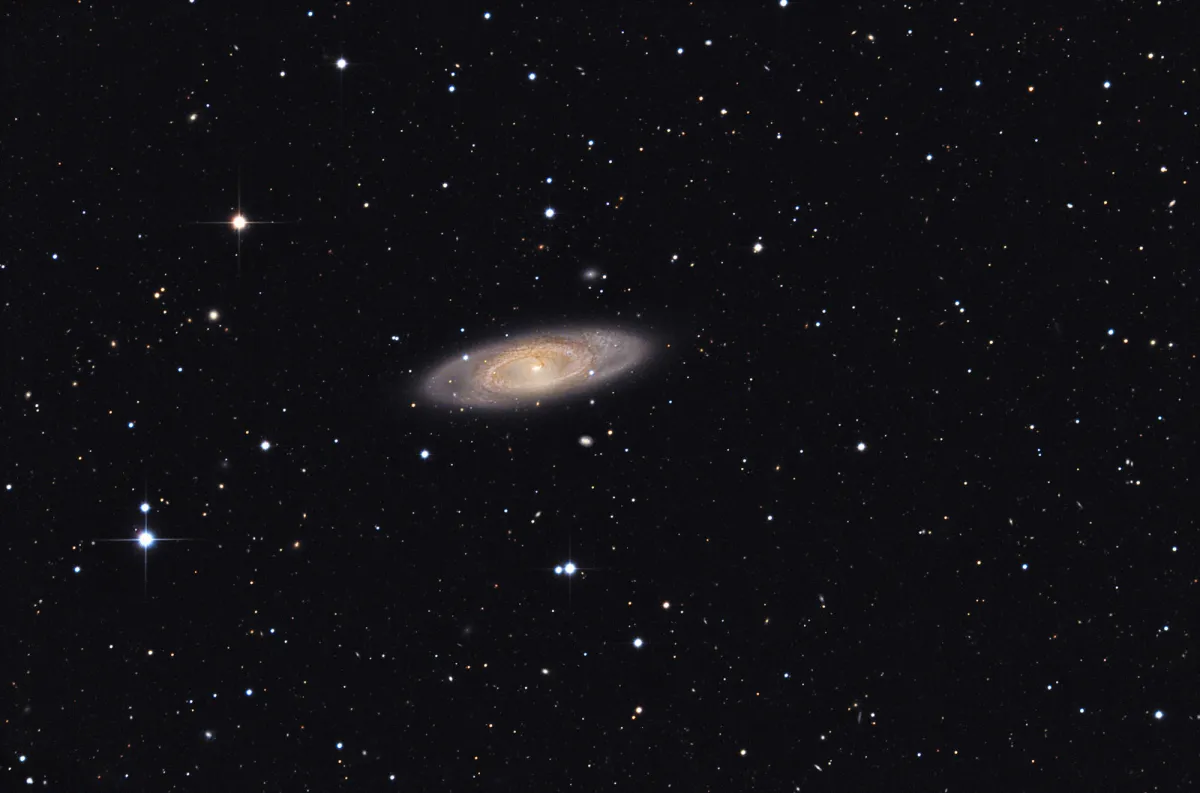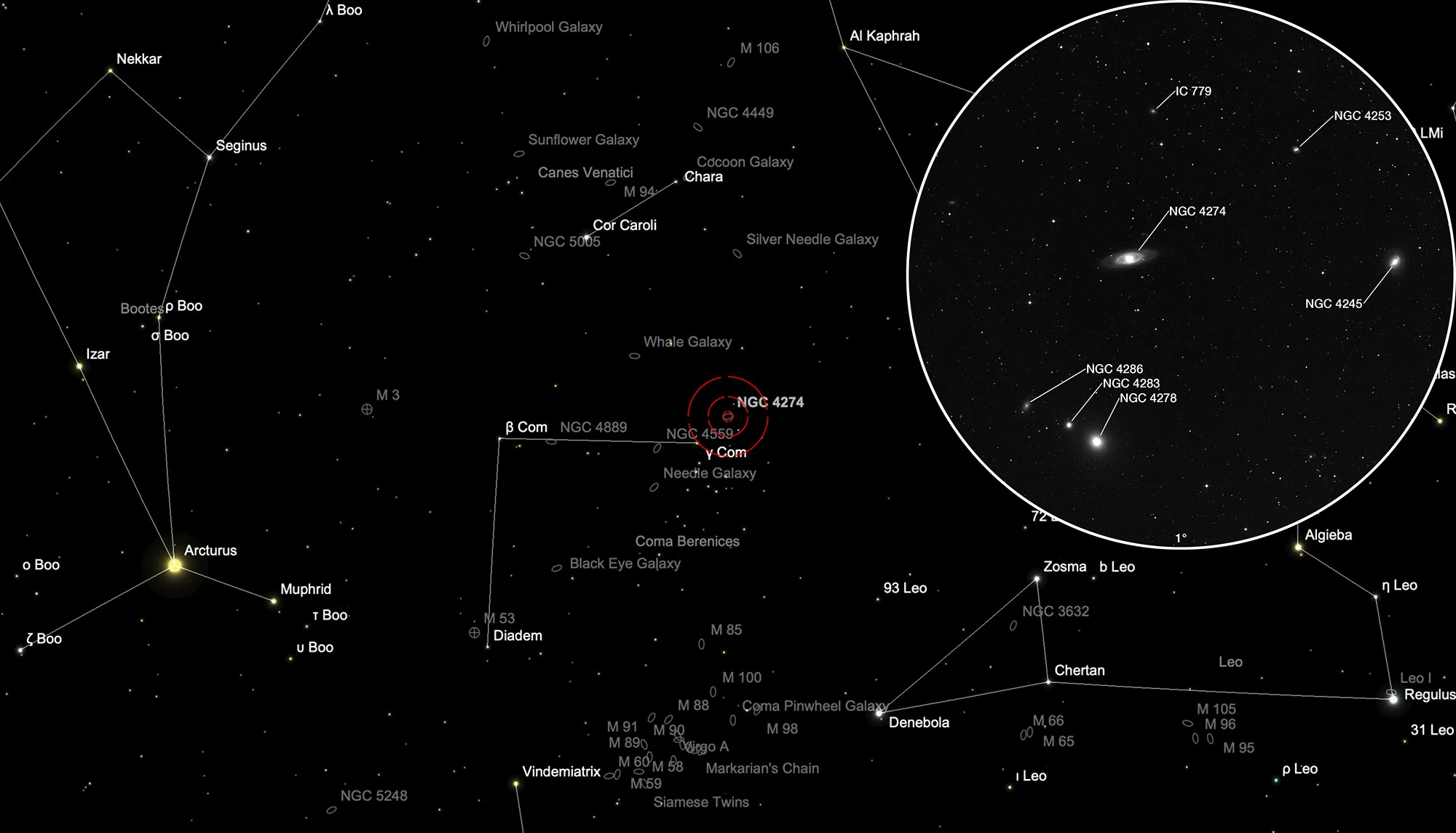Galaxie NGC 4274

Geschichte
Am 13. März 1785 entdeckte Wilhelm Herschel mit seinem 18.7-Zoll-Spiegelteleskop folgende Galaxien: I 74 (NGC 4245), I 75 (NGC 4274), II 322 (NGC 4278), II 323 (NGC 4283) und III 300 (NGC 4286). Im nächsten Monat, am 11. April, suchte er erneut diese Stelle des Himmels ab und fügte zwei Einträge hinzu, welche sich später als Duplikate herausstellten: I 90 (= II 322) und II 377 (= II 323). Etwa 3 Jahre später, am 3. Februar 1788, entdeckte Herschel dann noch die Galaxie II 377 (NGC 4283). [277, 463, 464] Schliesslich entdeckte Truman Safford am 16. Mai 1866 noch IC 779. Am 23. März 1903 entdeckte Max Wolf nochmals NGC 4286, welche als IC 3181 als Duplikat hinzugefügt wurde. [196]
Physikalische Eigenschaften
Laut HyperLEDA [134] gehören die Galaxien NGC 4245, NGC 4274, NGC 4278, NGC 4283 und NGC 4286 zur gleichen Galaxiengruppe (USGCU478), welche auch als NGC 4274 Galaxiengruppe bekannt ist. [458] Die Entfernungen dieser Galaxien liegen zwischen 7 und 17 Mpc. Die Galaxie NGC 4253 ist weiter entfernt (etwa 54 bis 65 Mpc) und IC 779 ebenfalls etwa 16 Mpc, scheint aber nicht zu dieser Gruppe zu gehören. [145]
Bei der Galaxie NGC 4274 handelt es sich um eine Balkenspiralgalaxie mit einer inneren und äusseren Ringstruktur. Sie ist vom morphologischen Typ (R)SB(r)ab mit einem aktiven Kern vom LINER-Typ. [194] Am 7. November 1999 wurde die Supernova SN 1999ev entdeckt. Sie erreichte eine Helligkeit von 14.4 mag. [303]
| Name | RA | Dec | Typ | bMag | vMag | B-V | SB | Dim | PA | z | D(z) | MD | Dreyer Beschreibung | Identifikation, Anmerkungen |
|---|---|---|---|---|---|---|---|---|---|---|---|---|---|---|
| NGC 4245 | 12 17 36.9 | +29 36 27 | Gx (SB0-a) | 12.3 | 11.4 | 0.9 | 13.3 | 2.9 × 2.2 | 165 | 0.002948 | 12.45 | 9.700 | cB, pL, vlE, smbM, r | WH I 74; h 1168; GC 2832; UGC 7328; MCG 5-29-49; CGCG 158-59; IRAS 12151+2952 |
| NGC 4253 | 12 18 26.4 | +29 48 47 | Gx (SBa) | 14.0 | 13.1 | 0.9 | 12.7 | 0.9 × 0.8 | 54 | 0.012929 | 54.61 | vF, vS, R | WH III 702; h 1172; GC 2837; UGC 7344; MCG 5-29-51; MK 766; IRAS 12159+3005; CGCG 158-61; KUG 1215+300 | |
| NGC 4274 | 12 19 50.8 | +29 36 49 | Gx (SBab) | 11.3 | 10.4 | 0.9 | 13.3 | 6.8 × 2.4 | 102 | 0.003102 | 13.10 | 16.830 | vB, vL, E 90°, mbMN | WH I 75; h 1185; GC 2851; UGC 7377; MCG 5-29-60; CGCG 158-71; IRAS 12173+2953 |
| NGC 4278 | 12 20 06.7 | +29 16 49 | Gx (E1) | 11.1 | 10.2 | 0.9 | 13.1 | 3.8 × 3.8 | 0.002165 | 9.14 | 15.180 | vB, pL, R, mbM, r, 1st of 3 | WH I 90, II 322; h 1186; GC 2855; UGC 7386; MCG 5-29-62; CGCG 158-77; IRAS 12175+2933 | |
| NGC 4283 | 12 20 20.6 | +29 18 39 | Gx (E0) | 13.0 | 12.1 | 0.9 | 12.9 | 1.5 × 1.5 | 0.003282 | 13.86 | 15.700 | B, S, R, bM, 2nd of 3 | WH II 323, II 377; h 1188; GC 2858=2859; UGC 7390; MCG 5-29-63; CGCG 158-80 | |
| NGC 4286 | 12 20 42.1 | +29 20 44 | Gx (S0-a) | 14.0 | 13.1 | 0.9 | 13.5 | 1.5 × 0.8 | 150 | 0.002148 | 9.07 | vF, 3rd of 3 | WH III 300; GC 2861=2863; IC 3181; UGC 7398; MCG 5-29-65; CGCG 158-83; KUG 1218+296 | |
| IC 779 | 12 19 38.7 | +29 52 58 | Gx (SBc) | 14.5 | 13.8 | 0.7 | 13.4 | 0.9 × 0.9 | 0.000741 | 3.13 | 16.520 | F | UGC 7369; MCG 5-29-53; CGCG 158-66 |
Auffindkarte
Die Galaxie NGC 4274 befindet sich im Sternbild Coma Berenices, etwa 2° nordwestlich des 4.3 mag. Sterns γ Comae Berenices. Am besten ist sie in den Monaten Dezember bis August zu sehen.
